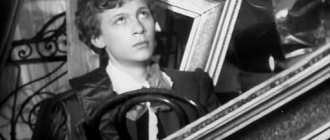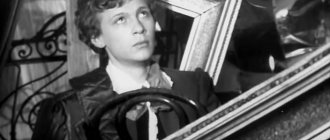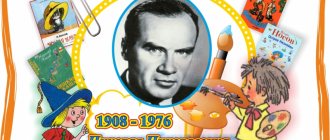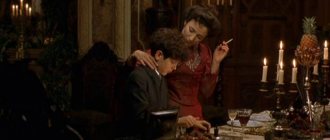Plot - summary
- Clown Edwards was distinguished by great talent and a kind disposition, but he often went on a drinking binge, and the director sternly warned him.
- The acrobat Becker took in a boy, Petya, whose mother had died.
- Becker was cruel and rude, he made a gymnast out of the boy, and only the clown Edwards felt sorry for the little artist.
- The children of Count Listomirov were looking forward to going to the circus; they wanted to see the famous gutta-percha boy.
- During the performance, Petya fell from the pole and was badly injured; screams and crying arose in the audience.
- Clown Edwards did not keep his word and got very drunk, and the boy’s name disappeared from the posters.
Summary by chapter
Chapter descriptions can be useful for keeping a reading diary. It will also help you prepare for your essay.
Chapter I Events develop in St. Petersburg in circus booths during the Maslenitsa holiday (late February).
Grigorovich describes in detail the atmosphere of the circus after the morning performance. Among the circus performers, the figure of Edwards the clown appears. He is a real favorite of the public, but he begins a sad period and the accompanying binge.
Edwards is concerned about the health of the gutta-percha boy, who has two more days to compete. He goes into the restroom where Becker is sitting and asks to let the tired child go for a walk. But Becker rudely refuses.
Chapter II A summary of the story about the life of a young acrobat shows how unhappy he was.
The gutta-percha boy's name is actually Petya, and he lost his mother in his fifth year. She was a Chukhonka (Baltic-Finnish people), her name was Anna. She worked as a cook and often changed jobs due to sloppiness and falling in love. Petit's father first worked as a porter, then he was drafted into military service, where he died in one of the campaigns.
They lived poorly, often went hungry, and their mother could not find work for a long time. Finally, thanks to the assistance of her compatriot Varvara, Anna got a job as a laundress and married a tailor for the second time. The stepfather drank, fought, disliked Petya and threatened to drown him. Soon the stepfather disappeared, and the mother fell ill and died.
Chapter III Petya lived either with the old lady next door or with Varvara. She decided to place him with familiar circus performers.
The book describes the despair of a child who was taken in by the rude and cruel acrobat Becker. At first, Petya was afraid of everything and hid, but gradually he got used to the noisy circus brethren. He was light and flexible in the joints, but his muscles were weak. They began to call him the “gutta-percha boy.”
Akrabat tests the boy's flexibility. Artist A.Z. Itkin
Becker forced him to train through pain. Sometimes Petya could not stand it and screamed. Clown Edwards stood up for him. Thanks to his advice, Petya was able to perform complex exercises, but he was still very afraid of Becker.
The acrobat did not monitor the child’s condition at all:
“...the underwear on the boy’s body was sometimes worn without change for two weeks, his neck and ears were not washed, and his boots were asking for porridge...”
Chapter IV The fourth chapter begins with a description of the children's rooms in the house of Count Listomirov. There are a lot of toys and books there.
“Colorful English colored notebooks and books, cribs with dolls, pictures, chests of drawers, small kitchens, porcelain sets...”
A luxurious dressing room is described in which the governess Miss Blix washes the children morning and evening. This environment is a clear contrast to the living conditions of the gutta-percha boy.
Aunt Sonya announces that since the children behaved well, they are going to the circus on Friday. Everyone is delighted, even the plump and phlegmatic Puff.
There is a description of the children: the eldest Verochka is 8 years old, the sickly Zina is 2 years younger, and Pavel is a boy of 5 years old, but everyone calls him Paf, he is his parents’ favorite.
Chapter V The Count and Countess are having breakfast in the dining room. Aunt Sonya joins them. The Countess doubts whether it is worth sending the children to the circus, because they are still small and so impressionable. But the melancholic and orderly Count does not mind.
Children enter the dining room. They are informed that their parents have given permission to go to the performance. Verochka grabs the poster and reads the names of the numbers. Among others, the performance of the gutta-percha boy was announced.
Chapter VI Before the start of the performance, there is a bustle at the circus box office, the orchestra is thundering. Children in a motley crowd in beautiful outfits stand at the barrier and look at the arena.
The performance begins with the entrance of the clowns. Then a fifteen-year-old girl, Amalia, performs on a horse, followed by a juggler. The gutta-percha boy comes out with Becker, dressed in flesh-colored tights and sprinkled with glitter.
Becker holds a long pole at his waist, and the boy climbs up it to the very top. He blows a kiss to the audience and starts demonstrating the exercises.
Performing exercises under the circus dome, artist V. Panov
Suddenly something flashed overhead and a booming sound was heard. It was the boy who fell down. The orchestra fell silent, and the audience began to call for a doctor. The circus attendants hastily ran out into the arena, picked up the body and carried it out.
After this, the orchestra started playing again, but people had already begun to crowd towards the exit. Verochka was most impressed by what she saw. She sobbed and constantly repeated: “Ay, boy! Boy!!".
The Count was very dissatisfied and indignant. They even wanted to call a doctor for Verochka, but in the end everyone calmed down and fell asleep.
Chapter VII In the circus corridor, a bandaged gutta-percha boy with broken ribs lies on a mattress. There is no one near him. Only occasionally does the clown Edwards approach, who is already overcome by melancholy and plunges into a drinking binge.
In the morning the boy's name was removed from the poster. His miserable life was over.
At the same time, the daughters and son of the count are surrounded by constant care and attention, they are not denied anything, they buy toys, they teach them to read and write.
Proverbs for the work
Without a mother, the sun does not warm.
Without a queen and a bee - lost children.
Don't feel sorry for the one who jumps, feel sorry for the one who cries.
Anyone can offend an orphan.
Pity is no help when death has come.
Back to Contents
Hello! My name is Maria, I am the author of the Pushkin website. I hope that my site helps you, in turn I ask for your help. My son was diagnosed with autism. He needs daily correctional activities, if you can help, I will be grateful to you. Every 10 rubles you give is another chance for my child to live a full life. Collection page here
Summary of “The Gutta-percha Boy” for a reader’s diary
Full name of the author : Grigorovich Dmitry Vasilievich
Title : Gutta-percha boy
Number of pages : 48. Grigorovich D. V. “Gutta-percha boy.” Publishing house "Drofa". year 2012
Genre : Story
Year of writing : 1883
The material was prepared jointly with a teacher of the highest category, Kuchmina Nadezhda Vladimirovna.
Experience as a teacher of Russian language and literature - 27 years.
Other characters
- Anna is Petya’s mother, a cook, and a good-for-nothing woman.
- Varvara is a laundress, Anna’s compatriot, a kind, sympathetic woman.
- Zina and Pavel are the youngest children of Count Listomirov.
- Aunt Sonya is the sister of Countess Listomirova, a loving aunt.
And we also have:
for the busiest -
Reader's diary “The Gutta-percha boy”
Other heroes
Pavel Listomirov (his home nickname is Paf) is the complete opposite of the gutta-percha Petya, who never slept enough or ate his fill in his short life. Puff is short, plump, with a round face, he has an extremely calm disposition and generally reacts little to what is happening around him.
He finds going to the circus interesting, and his relatives are even surprised by this, since Puff’s thoughts are usually focused only on food. At the same time, Count Listomirov pays more attention to his son. Alone with himself, however, he does not think about what to teach his son, but only dreams about how he will make a career in the public service.
Six-year-old Zizi cannot be called happy either. She is literally stuffed with medications, among which, according to the author, cod oil plays an important role. It only makes the poor girl hysterical. Although, in fact, all she needs is just movement and walks in the air, but this is precisely what is not allowed in the count’s house.
We can say that the main idea of “The Gutta-percha Boy” is that children are the future of the country. But there are simply no happy children in it. Even those who grow up in greenhouse conditions, in wealth and comfort, do not feel happy. As for all other classes, the same burden falls on the shoulders of children as on adults, and it is often felt more acutely.
Meanwhile, it is how children are treated in society that is an indicator of the development of society as a whole. Grigorovich tries to draw the attention of readers to the fact that in Russia of that era this was a huge problem, which ultimately led to a social explosion and revolution.
Scions of Counts Listomirov
In the story “The Gutta-percha Boy” the main characters are not only Petya and other circus performers, but also the children of Count Listomirov. Eight-year-old Verochka, her younger sister Zina and brother Pavel (Paf) grew up in luxury, and were surrounded on all sides by affection. In the last days of Maslenitsa, as a reward for good obedience, children were taken to a circus performance. Verochka learned from the poster that a gutta-percha boy would perform in one of the acts and she couldn’t wait to see him.
Acrobat Becker and boy Petya
Next, Grigorovich (“The Gutta-percha Boy”) introduces us to other characters in the story. The main characters of the work are Edwards, Becker and Petya. We have already met the first of them. To introduce the other two to the reader, the author describes the following scene.
Edwards looks into the closet of Becker, the acrobat. He is a muscular and brute giant. It is not Becker himself that interests Edwards, but the “gutta-percha boy” Petya, his pet, the acrobat’s assistant. Edwards asks if he can go out with him. He proves to Becker that the little artist will work better after entertainment and rest. The acrobat, always irritated by something, does not even want to hear about it. He threatens the boy with a whip.
Gutta-percha boy summary
’s “Gutta-percha Boy ,” written in 1883, describes the difficult fate of the little orphan Petya, who was sent to be trained as a circus performer. The emotional component of the work is very strong and leaves no one indifferent. On our website you can read online a chapter-by-chapter summary of “The Gutta-Percha Boy ,” which will be useful in preparing for a literature lesson and for a reading diary.
The main characters are Petya - an eight-year-old boy, an orphan, a student of a circus acrobat. Becker is a narcissistic strongman, an acrobat, a cruel and insensitive person. Edwards is a talented clown, a kind, compassionate man, strongly attached to Petya. Verochka is the eldest daughter of Count Listomirov, an eight-year-old girl, kind, sensitive, and very vulnerable. Other characters Anna is Petya’s mother, a cook, and a good-for-nothing woman. Varvara is a laundress, Anna’s compatriot, a kind, sympathetic woman. Zina and Pavel are the youngest children of Count Listomirov. Aunt Sonya is the sister of Countess Listomirova, a loving aunt. Summary
Chapter I Residents of St. Petersburg celebrate the fifth day of Maslenitsa. Circus performers perform in the morning and evening: they have already changed their clothes and washed off their bright makeup after the morning performance, and are ready to leave the circus premises. The director asks the clown Edwards and Frau Braun to stay, next to whom stands her daughter, a thin girl, an equestrian. The director scolds the woman because her daughter fell three times during the performance and thereby greatly frightened the audience. The director also does not inspire confidence in the clown Edwards, who is “the soul of the circus, its main decoration, its main bait.” But during a period of melancholy, he could break down at any moment and go on a heavy binge. The director asks him to hold out for at least a couple of days, until the end of Maslenitsa, when the circus closes for the duration of Lent.
Chapter II The real name of the “gutta-percha boy” is Petya. The story of his life is short, because he was “only eight years old.” His mother was an “eccentric, although kind, Chukhonka” named Anna, who served as a cook. Having married a doorman, she settled in his tiny closet, and soon gave birth to a frail and sickly boy, who was named Petya. The doorman was drafted into the army, and after a while Anna received news of his death. The cook and her young son began to have a hard life - no one wanted to take her to work with such an additional weight. The situation worsened even more when Anna married a heavy drinking man. He immediately hated Petya fiercely and “threatened to drown him in the ice hole.” My stepfather drank away all the money, and often there was not even bread in the house. Exhausted by constant hunger, Anna died, leaving Petya in the care of her compatriot, the laundress Varvara.
Chapter III Varvara lived next door to the circus performers. Sometimes she took Petya to her place, and soon everyone learned the sad story of his life. In conversations, Varvara often mentioned how nice it would be if “one of the gentlemen took pity and took the orphan as an apprentice.” No one expressed such a desire, and only the acrobat Becker thought about something. One day, Varvara brought the frightened Petya to Becker for an examination - “the acrobat promised to take him in as an apprentice if he turned out to be suitable.” Noticing the boy's natural flexibility, he agreed to take him on as a student. Petya could not get used to his master, whom he was very afraid of, but “it became especially difficult for him when the training began.” The main difficulty for Petya was that while performing complex acrobatic stunts, his “face had to maintain the most pleasant, laughing expression.” Petya's life with Becker was not at all sweet: the boy lived from hand to mouth, wore only rags, did not wash for a long time, and never heard a single kind word from his mentor.
Chapter IV In the children's rooms of Count Listomirov, everything was created for fun, learning and the general comfort of his offspring. For their diligent behavior, Aunt Sonya, their mother’s sister, promised to take them to the circus. The children are excited because they have been dreaming about this for a long time. “The eldest girl, Verochka, was already eight years old; behind her was six-year-old Zina,” and after that was five-year-old Pavel, whom his family called Paf. Since then, “as the performance at the circus was promised,” Verochka vigilantly monitored the behavior of her sister and brother, so as not to inadvertently anger the adults and not be left without the circus. Thanks to her pretty appearance and gentle disposition, she was the favorite of the whole family.
Chapter V During a formal breakfast with her parents, Verochka discovers circus posters. She asks her mother for one, and, comfortably settling down in the nursery, begins to study it carefully. Her attention is drawn to the number with the gutta-percha boy, and she bombards Aunt Sonya with numerous questions. A snowstorm threatens the trip to the circus, and Verochka is nervous all day. Her face clears up only with the news that “the Count and Countess ordered the children to be dressed and taken to the circus.”
Chapter VI The children take their seats and look at the circus arena with interest. According to custom, the evening performance begins with the clown Edwards, “a fat white horse was hastily brought out to replace him,” with a thin rider who had fallen three times in the morning. Then it’s the turn of jugglers, trained dogs, and tightrope walkers to perform. Finally, Becker and Petya enter the arena. On a long pole held by Becker, the boy demonstrates various tricks and, while performing the most difficult of them, unexpectedly falls from a great height to the floor. The tragedy that unfolded before Verochka’s eyes deeply wounds her. All evening she does not stop crying, thinking about the unfortunate boy.
Chapter VII In the inner corridor of the circus lies “a child with broken ribs and a broken chest.” Only occasionally does the hunched figure of an elderly clown appear from the darkness, who comes to visit the dying boy. Unable to keep his promise to the director, he goes on a drinking binge. The next morning, the performance of the gutta-percha boy no longer appeared in the circus posters - he “was no longer in the world”...
Conclusion Dmitry Grigorovich's story teaches empathy, the ability to understand the grief of another person, and not remain indifferent at the sight of cruel injustice. After reading a brief retelling of “The Gutta-percha Boy,” we recommend reading Grigorovich’s story in its entirety.
Developments
One day, Varvara took her ward by the hand and took her to the circus pavilion. It turns out that the acrobat agreed to take him in, but first wanted to hold a review. He immediately noticed the boy’s excellent gutta-percha - he was incredibly flexible by nature.
The boy was very afraid of the strict Becker, but the most difficult thing lay ahead of him. Daily training exhausted the little artist. In addition, during acrobatic stunts it was necessary to smile, but his face became stone from fear. Petya’s life in the new conditions has practically not changed, he:
- lived from hand to mouth;
- wore dirty and shabby clothes;
- received kicks and slaps on the head from the mentor;
- I haven't washed for months.
The atmosphere was completely different in the house of Count Listomirov - it was warm, comfortable and fun. All conditions were created for children. For good behavior and excellent grades, the aunt promised to take the children to a circus performance, so there was an excited atmosphere in the room, everyone was waiting for a fairy tale. There were three offspring in the family:
- seven-year-old Verochka;
- six-year-old Zina;
- five-year-old Pavel, his family simply called him Paf.
The older girl closely watched the younger ones so that they would not misbehave. She was afraid that her parents would cancel the trip to the circus. But still, the long-awaited day came: they put on beautiful outfits and went to watch the performance.
Having taken their seats, the children look at the hall with great interest. The show opens with the cheerful clown Edwards. He is followed in turn by:
- a thin rider on a white horse;
- magnificent jugglers with burning torches;
- dog trainer;
- virtuoso tightrope walker.
Becker and little Petya complete the performance. The boy performs dangerous jumps on a pole held by his mentor, and then demonstrates the most difficult trick. But suddenly something doesn’t go according to plan, and the young acrobat falls from a great height.
The accident touches the viewer Verochka to the depths of her soul; she sheds tears all evening and thinks about the unfortunate acrobat. The circus continued to operate as before, but without little Petya. This is what the short story “The Gutta-percha Boy” looks like.





